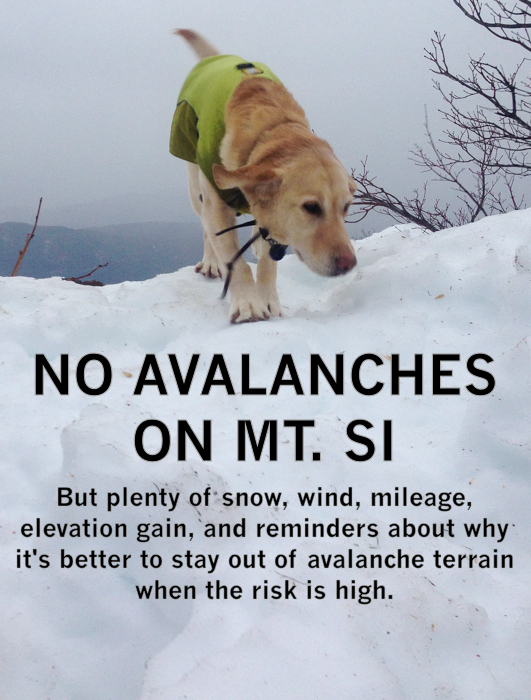Sundays are my day for adventuring in the mountains. I go early so I can be home before the family wakes up. I hike in the dark, the rain, and the snow. Very little stops me, but the thought of being buried in the snow is enough to force me to lower ground.
On this particular Sunday the avalanche danger was "High." High means that natural avalanches are likely and human-triggered avalanches are very likely. Travel in avalanche terrain is not recommended. So I bailed on even the relatively safe Mailbox Peak and headed up Mt. Si instead.
Mt. Si isn't one of my favorites, but it's close and safe. Treen and I braved high winds on the upper third of the mountain, but the snow was well consolidated and at least it wasn't raining.
I've taken a couple of avalanche classes and the number one, most important, absolutely vital piece of information I learned was that the best way to not be buried in an avalanche is to not go where there are avalanches.
Well, duh.
But the problem with not going where there are avalanches is that's where we all want to go. It's where the killer views and epic adventures are. It's where the snow is the deepest and the fun quotient is the highest.
It'll also be there next week and next month. If the snow melts before we get there it'll be back next winter. There's no reason to push the boundaries of safety when the risk is so high.
So I retreated to Mt. Si. No, not "retreated." I made a strategic withdrawal. The hike was good, but not great and certainly not epic. And I'll still be around to climb next weekend. And the weekend after.
If you're heading into the snow you should at least know what avalanche terrain looks like and the forecasted risk. You need to be able to avoid the risk you can't accept.
Take a class. It doesn't have to be an AIARE class and you don't have to get a certification, but you do need to know what avalanche terrain looks like and the warning signs of unstable snow.
avalanche.org class listing
AIARE classes
Use your head. Know the avalanche danger before you go. Remember that the only way to guarantee you'll be safe from an avalanche is to not go into avalanche terrain when there's a risk of a slide. How much risk? I can't say. I know my tolerance is pretty low. You'll have to figure it out for yourself. If you're in the Northwest NWAC is your go-to forecaster. If you're somewhere else, find your local Avalanche Center at avalanche.org.
Get the gear. You shouldn't go into avalanche terrain, regardless of the risk, without the proper gear. Not because it will save you, but so you can save someone else. Sure, a transceiver like the BCA Backcountry Access Tracker will help someone find you if you get buried. But the tranceiver along with a shovel like the Ortovox Beast and a probe like a Black Diamond Quickdraw can help you save your friends as long as you know how to use them. (These are Amazon affiliate links that help support moosefish.com. Click here for more info.)
This is just the start of a journey toward being safer in the mountains. Continue it online at sites with educational information like backcountryaccess.com.
But like all risk, unless we avoid it we can't reduce it to zero. There's always some chance that snow will course down the mountain when someone's in the wrong place. Do whatever you can to reduce the likelihood it's you standing in the path of the avalanche. Mt. Si is a heck of a lot nicer than being trapped under the snow.
